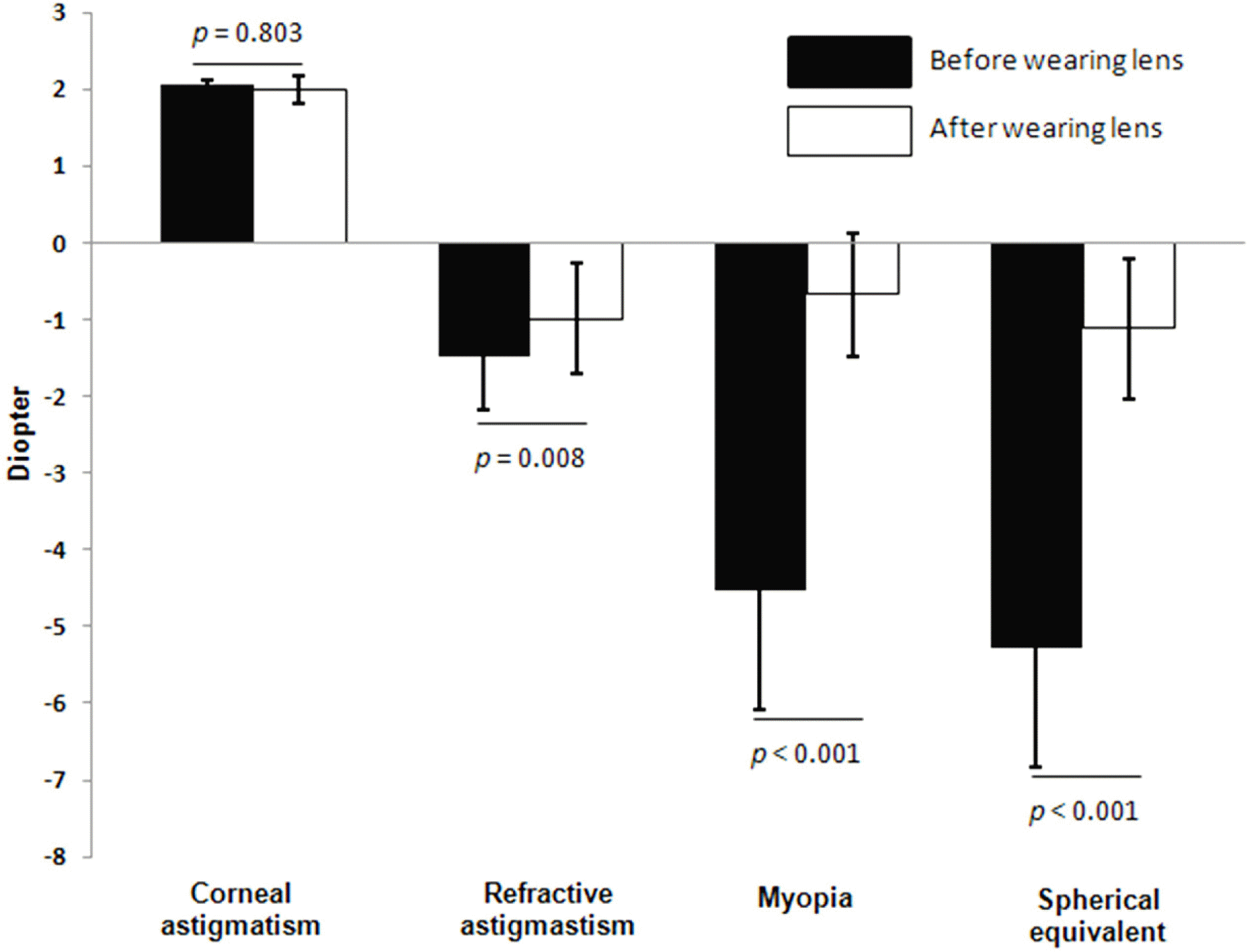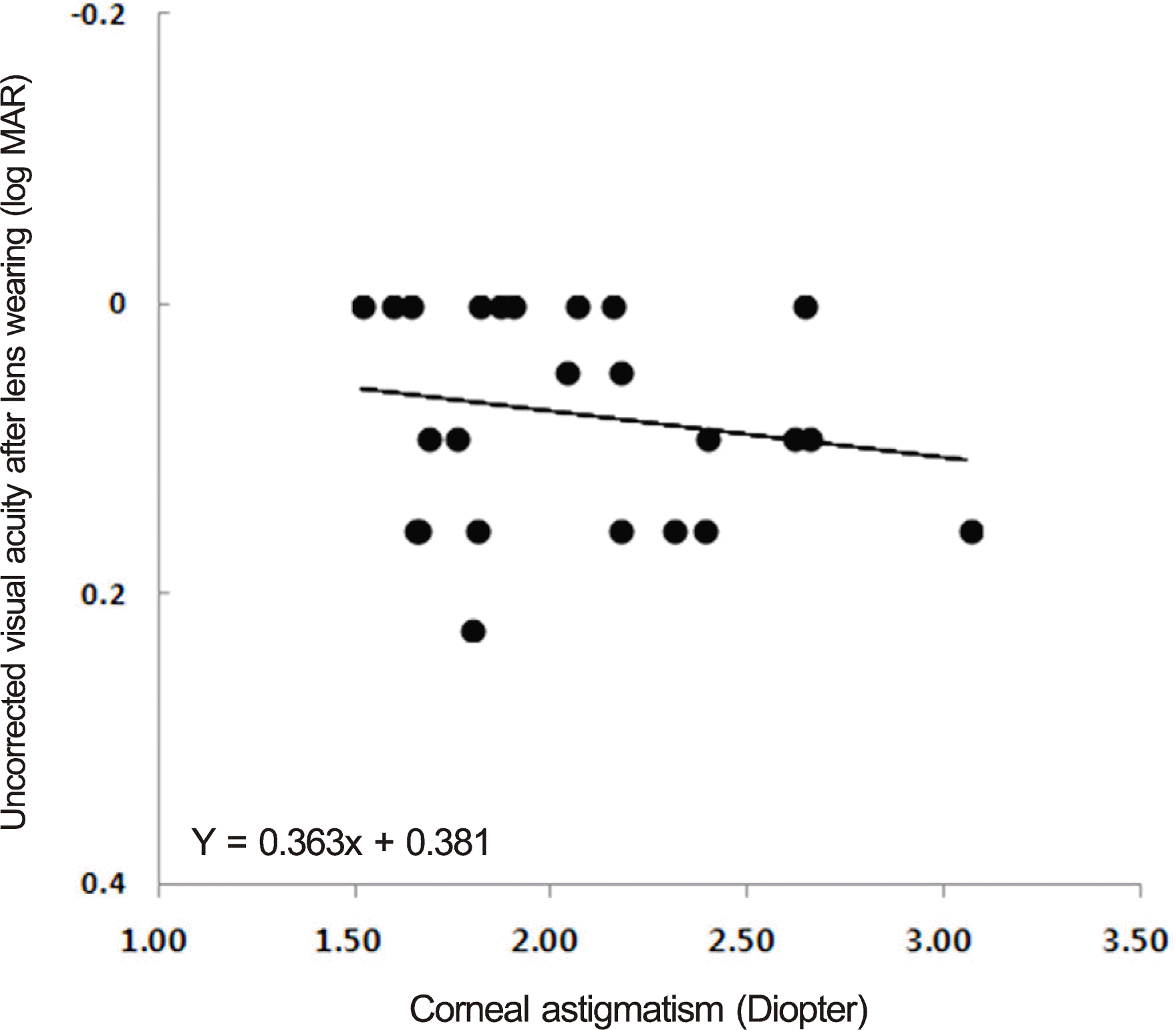Abstract
Purpose
To report the effect of toric orthokeratology lenses on myopic patients who have more than 1.5 diopter (D) of corneal astigmatism.
Methods
Seventeen patients (24 eyes) who wore toric orthokeratology lenses for more than 6 months were recruited for this study. The uncorrected visual acuity (UCVA), refractive error and keratometric changes including eccentricity before and after wearing lenses were compared. The correlations between corneal astigmatism as well as refractive astigmatism and lens toricity and between corneal astigmatism and improvement of UCVA after lens fitting were assessed.
Results
After wearing lenses, UCVA (log MAR) was significantly improved from 0.93 ± 0.13 to 0.09 ± 0.07 (p < 0.001). Myopia changed from -4.53 ± 1.55 D to -0.67 ± 0.80 D (p < 0.001), refractive astigmatism from -1.48 ± 0.71 D to -0.99 ± 0.72 (p = 0.008) and spherical equivalent from -5.27 ± 1.56 D to -1.12 ± 0.92 D (p < 0.001). Simulated K (Sim K) tended to be more flat (p < 0.001) and the eccentricity was significantly decreased from 0.45 ± 0.08 to -0.69 ± 0.45 (p < 0.001), but corneal astigmatism was not significantly changed from 2.05 ± 0.41 D to 2.01 ± 0.98 D (p = 0.803). Correlation between corneal astigmatism and lens toricity was statistically significant (r = 0.526, p = 0.012) but not between refractive astigmatism and lens toricity (r = 0.218, p = 0.329). The amount of corneal astigmatism was not correlated with the improvement of uncorrected visual acuity after lens fitting (r = 0.1804, p = 0.399).
Conclusions
Toric orthokeratology lenses might be an effective treatment in patients with corneal astigmatism who cannot be fit-ted with spherical orthokeratology lenses. Lens toricity was correlated with corneal astigmatism and the amount of corneal astigmatism did not affect the improvement of uncorrected visual acuity after lens fitting.
References
1. Cheung SW, Cho P. Subjective and objective assessments of the effect of orthokeratology-a cross-sectional study. Curr Eye Res. 2004; 28:121–7.
2. Tahhan N, Du Toit R, Papas E, et al. Comparison of reverse-geom-etry lens designs for overnight orthokeratology. Optom Vis Sci. 2003; 80:796–804.

3. Chan B, Cho P, Cheung SW. Orthokeratology practice in children in a university clinic in Hong Kong. Clin Exp Optom. 2008; 91:453–60.

5. Mountford J, Noack D. Corneal topography and orthokeratology: post-fit assessment. Contact Lens Spectrum. 2002; 17:6. http://www.clspectrum.com/articleviewer.aspx?articleID=12163. Accessed November 11, 2014.
6. Park YK, Lee JS, Lee JE. Correction of limbus-to-limbus corneal astigmatism with toric orthokeratology lenses. J Korean Ophthalmol Soc. 2013; 54:502–7.

7. Choi JH, Ryu JW, Lee YC, Kim HS. An analysis of correlation with visual acuity, refractive error and corneal astigmatism after wearing of reverse geometry lenses. J Korean Ophthalmol Soc. 2006; 47:1266–73.
8. Nichols JJ, Marsich MM, Nguyen M, et al. Overnight orthokeratology. Optom Vis Sci. 2000; 77:252–9.

9. Mountford J. An analysis of the changes in corneal shape and refractive error induced by accelerated orthokeratology. International Contact Lens Clinics. 1997; 24:128–43.

10. Fan DS, Rao SK, Cheung EY, et al. Astigmatism in Chinese pre-school children: prevalence, change, and effect on refractive development. Br J Ophthalmol. 2004; 88:938–41.

11. Kleinstein RN, Jones LA, Hullett S, et al. Refractive error and eth-nicity in children. Arch Ophthalmol. 2003; 121:1141–7.

12. Chen C, Cho P. Toric orthokeratology for high myopic and astigmatic subjects for myopic control. Clin Exp Optom. 2012; 95:103–8.

13. Chen CC, Cheung SW, Cho P. Toric orthokeratology for highly astigmatic children. Optom Vis Sci. 2012; 89:849–55.

14. Chen C, Cheung SW, Cho P. Myopia control using toric orthokeratology (TO-SEE study). Invest Ophthalmol Vis Sci. 2013; 54:6510–7.

15. Soni PS, Horner DG. Orthokeratology. Bennett ES, Weissman BA, editors. Clinical contact lens practice. Philadelphia: JB Lippincott;1993. chap. 49.
16. Joe JJ, Marsden HJ, Edrington TB. The relationship between corneal eccentricity and improvement in visual acuity with orthokeratology. J Am Optom Assoc. 1996; 67:87–97.
17. Yun YM, Kim MK, Lee JL. Change of corneal parameters after re-moving reverse geometry lens in moderate degree myopia. J Korean Ophthalmol Soc. 2005; 46:1478–85.
Figure 1.
Comparison of refractive changes between before and after wearing toric orthokeratology lens. Only corneal astigmatism was not changed significantly after wearing lens.

Figure 2.
Correlation between corneal astigmatism before lens wearing and improvement of uncorrected visual acuity (UCVA) after lens wearing. Improvement of UCVA was not correlated with pre-fitting corneal astigmatism (r = 0.1804, p = 0.399).

Table 1.
Demographics of patients
| Patients | |
|---|---|
| Eyes (number) | 24 |
| OD/OS (eyes) | 11/13 |
| Male/female (number) | 7/10 |
| Age (year) (range) | 15 (6-40) |
| Follow up period (months) (range) | 8 (6-17) |
Table 2.
Comparison of uncorrected visual acuity, refractive error, and keratometric value




 PDF
PDF ePub
ePub Citation
Citation Print
Print


 XML Download
XML Download